In this brief article I will outline the first steps you might take to start your own podcast. There are lots of options to any of the equipment mentioned here and St Emlyn’s is not supported by any manufacturers.
Starting your own podcast seems to be all the rage at the moment. As a listener there is almost too much choice. So, before you go any further I want you do ask yourself a series of questions….
Why are you doing this?
Good reasons for making a podcast
Reason 1 – For some the pleasure is purely in the making of a podcast: the research, the recording and editing. Listeners don’t matter.
Reason 2 – For some it is about sharing a passion. To spread the word to others. Here, one listener might be enough.
Reason 3 – For some it is about using their knowledge to fill a gap. A larger number of listeners would satisfy this wannabe podcaster.
Reason 4 – For some it is about World Domination – unless you have a father who is secretly writing bad porn in the garden shed, or you stared in a hit television show I’d suggest this isn’t you.
If you don’t fit any of these categories I’d probably stop reading now, as the effort required to make a half decent podcast is going to outweigh any benefit you get from it.
Bad reasons for making a podcast
Bad reason 1 – It’ll make you money – No. No it won’t. In fact it’ll probably cost you money in the long term.
Bad reason 2 – You want to be famous. No. That won’t happen (see reason 4 above).
Bad reason 3 – It’s easy. No. No it isn’t.
I want to go ahead and make a podcast…
1, Topic – Think very hard about the topic and content. Most podcasts are between 20-30 minutes long. What would you say? Are you doing this alone (if it’s one person speaking into a microphone it’s really hard to be interesting unless you are Bob Mortimer).
2, Time – When will you be able to research, record and edit? Don’t underestimate this. A twenty minute podcast probably takes about five hours to make from start to finish.
3, Technical ability and kit – You do not need to spend much money at the start. As I’ll outline below you can make a start with a relatively cheap microphone as your only expense (assuming you have a computer). Most of the skills you need can be learned as you go along and YouTube is a library of useful information.
So how do I actually make a podcast?
Recording
Let’s set up the kit…
1, Attach a microphone to your computer – if you really don’t want to spend anything yet you can just use the built in microphone, although it’s hard to make this sound good. I’ve been this Samson model (about £50) which has served me well. This is a USB microphone so will plug directly into a port on the side of your PC.
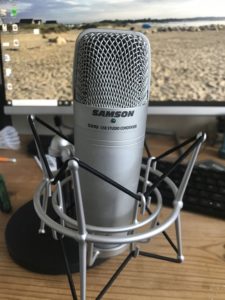
2, Download an audio recording programme. I use Audacity – a free programme that I’ve found really easy to use. There are also lots of instructional videos on YouTube if you get stuck.
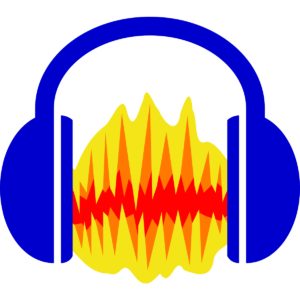
If you are recording a podcast on your own that’s pretty much it. Just open up Audacity, press the red record button and off you go. If you’d like to record with more than just you then read on.
I think podcasts often sound best if there are like an overheard conversation. You can either record with you both in the same room, or use a programme like Zencastr. This Zencastr records each voice locally so you won’t suffer from dropouts due to a bad connection. You simply send a link to your podcasting chum and you’ll both be recorded on separate tracks that can be edited later.
Editing
This is probably the most time consuming part of making any podcast.
Once you have recorded your audio (on Zencastr it’ll be in an mp3 format) you can then import this into Audacity and you’ll be confronted with something that looks like this.

At first this will seem incredibly intimidating, but really it needn’t be. If you can use cut and paste on Word you’ll be fine. All of the “keys” for play/stop/record etc are easily recognisable from a CD player (remember those).
As you listen back to your recording, you can simply highlight anything you don’t like and press delete. It really is that easy.
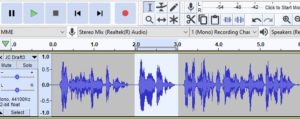
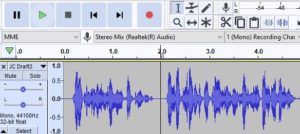
You have a few choices to make about your editing style. Some people leave it “au naturel” with all the coughs, breaths, ummms and errrs. You can of course take all of these out, but it will take a lot more time and you run the risk of your podcast sounding rather unnatural.
Once you’re happy with your edit I would run it through a programme like auphonic, which matches all of the levels so your podcast will sound smoother. It also, very handily, will convert you WAV file from audacity into a more useable mp3 file. You get a few hours free per month, so you really have nothing to loose.
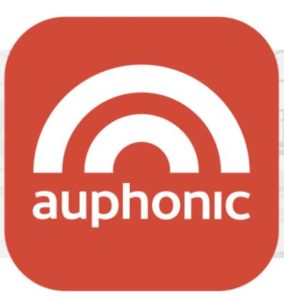
There’s much more about editing on this short podcast.
Publishing
This is the most exciting step. When you can finally share your podcast with the world.
There are lots of podcast hosting sites to choose from (many of which will give you a certain amount free per month). We have been using Podbean for all our St Emlyn’s podcasts and it’s been pretty reliable.
From here it is only a few clicks to get you podcast published on iTunes and subsequently on Spotify.
Good luck with your podcasting. It’s been (in those rather terrible X factor words) an incredible journey for me, but one that I have hugely enjoyed.
All best,
Iain